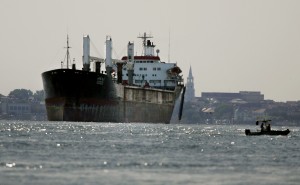
(AFP Photo)
The government plans to launch the tender for the development of Safaga Mining Port in March in cooperation with the Public Private Partnership Central Unit of the Ministry of Finance.
According to the head of the executive arm of the Industrial and Mining Projects, Osama Hashad, financial, technical and economic studies for the development of the port have been prepared. This has occurred in partnership with the German Consultant Office, Hamburg Port Consulting and PPP Central Unit. The funding is provided by the Islamic Development Bank and the International Finance Corporation (IFC).
Capital cost for the project’s development is EGP 1.2bn and will provide 12,000 job opportunities, Hashad said.
The first phase of development enterprise includes three projects, the first of which will build the main infrastructure for a phosphoric acid circulation terminal. The second establishment is a dry bulk of station for wheat, milling industry and the mobilisation of milling products. The third is a station for animal trade.
Safaga Mining Port is located 8km south of Safaga Commercial Port, and specialises in exporting phosphate ore. It has a reserve of 1.2bn tonnes concentrated in the areas of the New Valley, Edfu and the Red Sea, according to Adam Mahfouz Taha, maritime transport consultant for the project.
According to the project consultant, the cost of liquid bulk circulation terminal amounts to $90m and the internal revenue rate is 25% with a capital recovery time of 7.5 years. The cost of dry bulk terminal is at $60m.
The internal revenue rate of the second project is 9% and a capital recovery time of 13 years, according to the project consultant. The third project costs will be $20m, and its internal revenue rate is 14% with a capital recovery time of 10 years.
“The port will be the first of its kind in the region. It will work to increase the commercial traffic in the Red Sea between Egypt and its neighbour countries by increasing its capacity,” said Mahfouz Taha.
According to Taha, the project aims to utilise the production surplus of sidewalks and plazas already existing at the port to set up a trading station linked with the establishment of these station industries. This will reduce the cost of supply chain for these industries.
According to the project consultant, following the development, the port will be capable of handling 1.5m tonnes per year of phosphate for export, and up to 1m tonnes per year of phosphoric acid for export. It will also be capable of handling imports of 500,000 tonnes per year of sulphur, as one of phosphoric acid’s production requirements.




